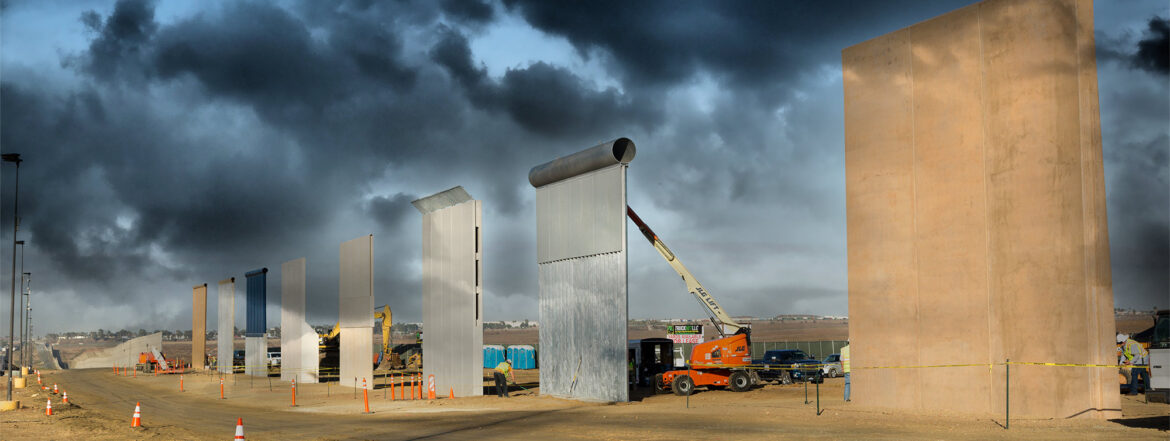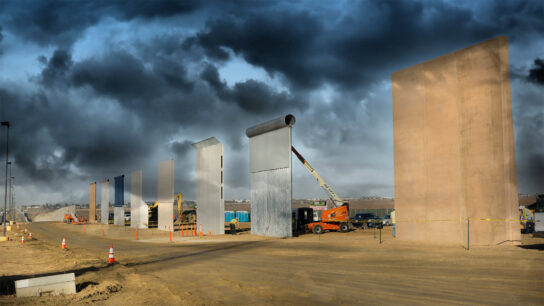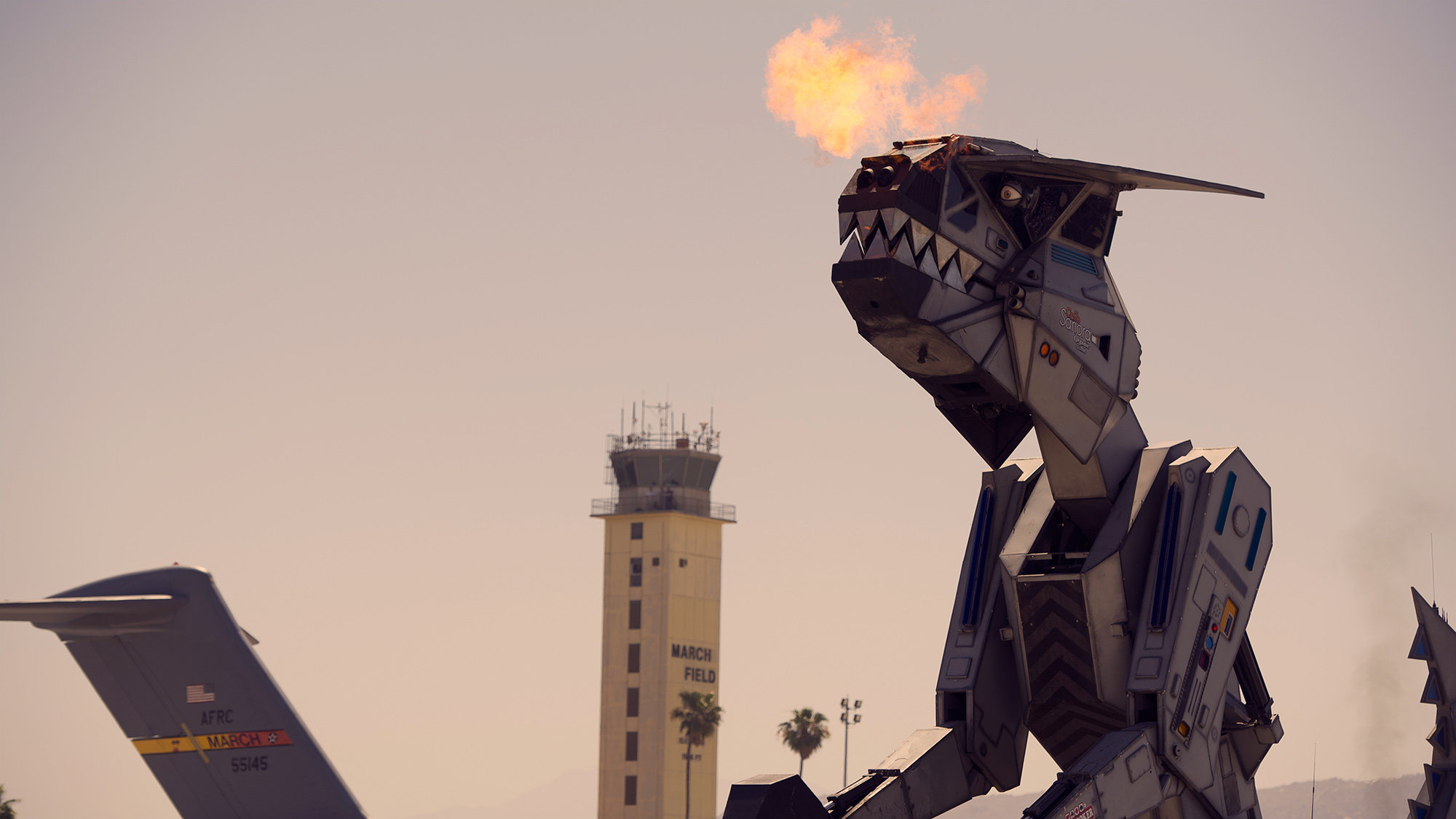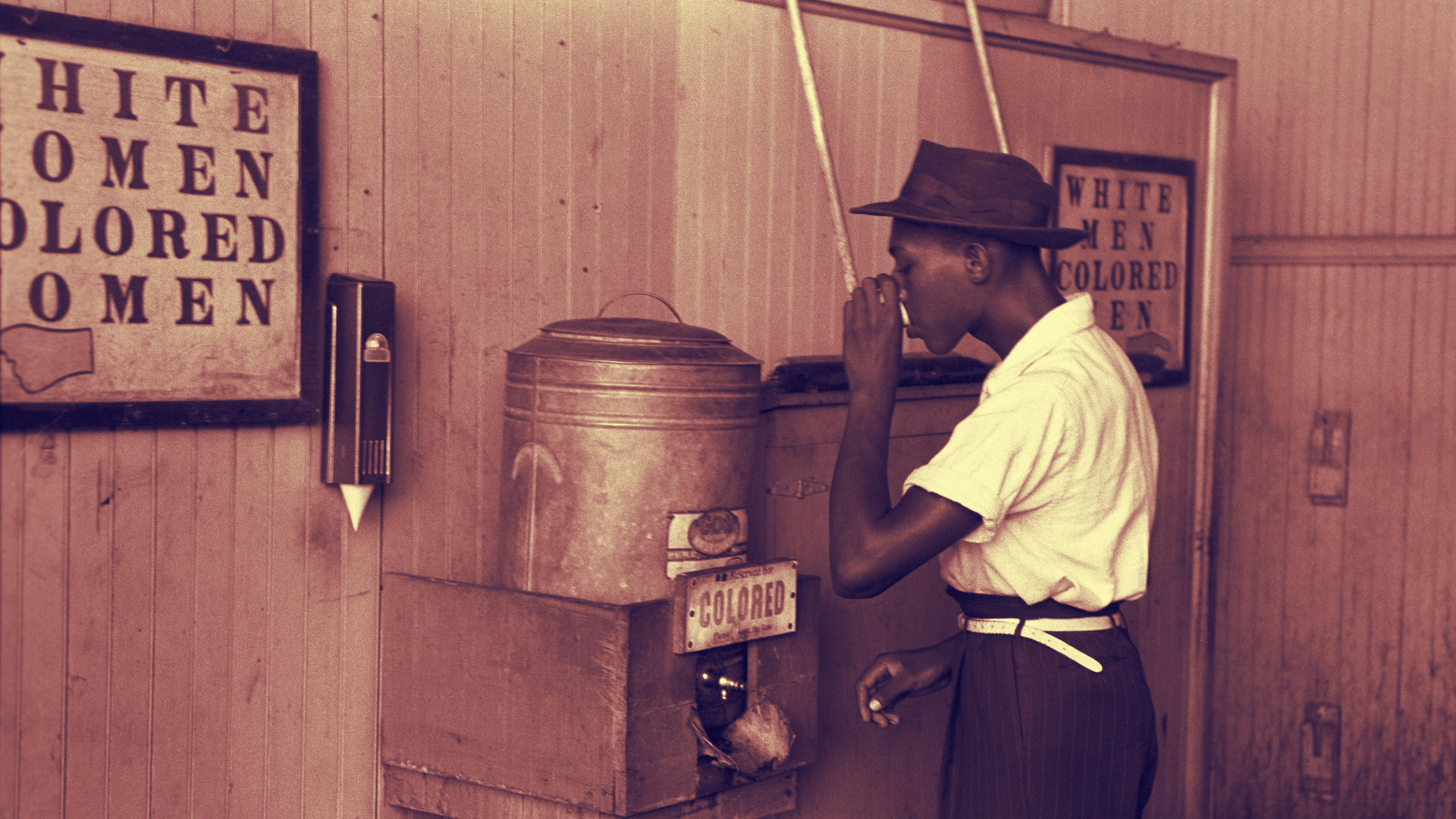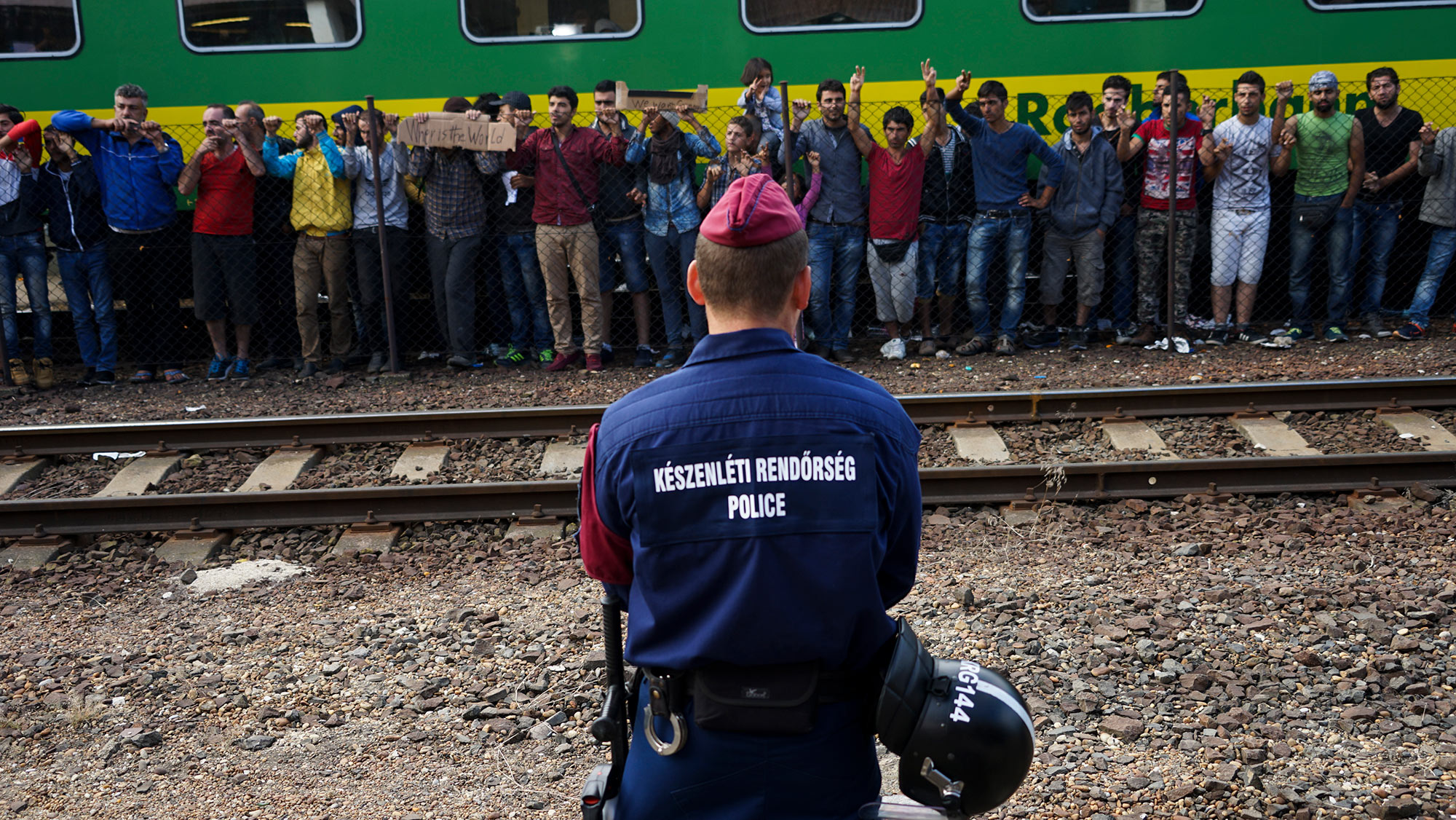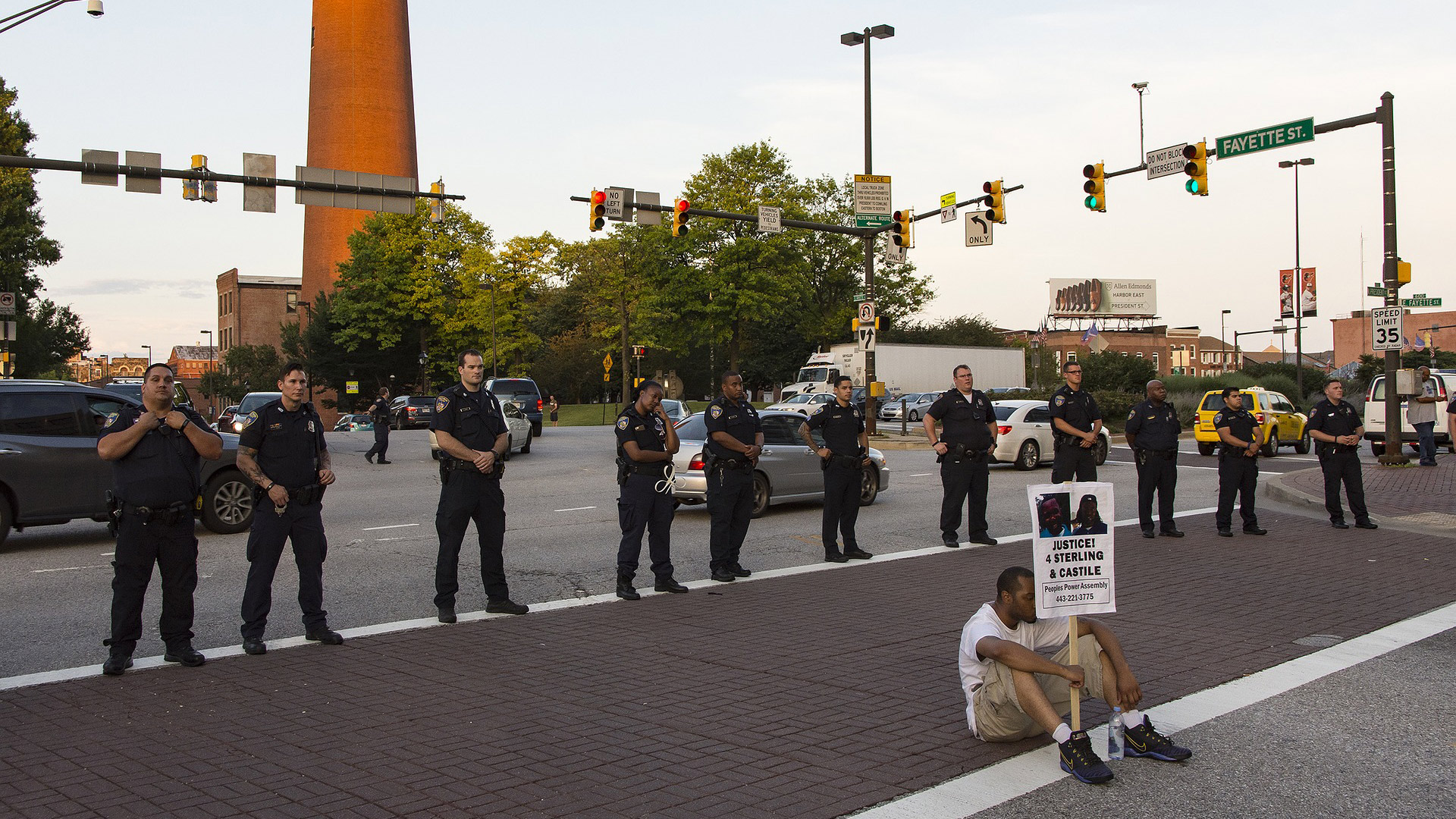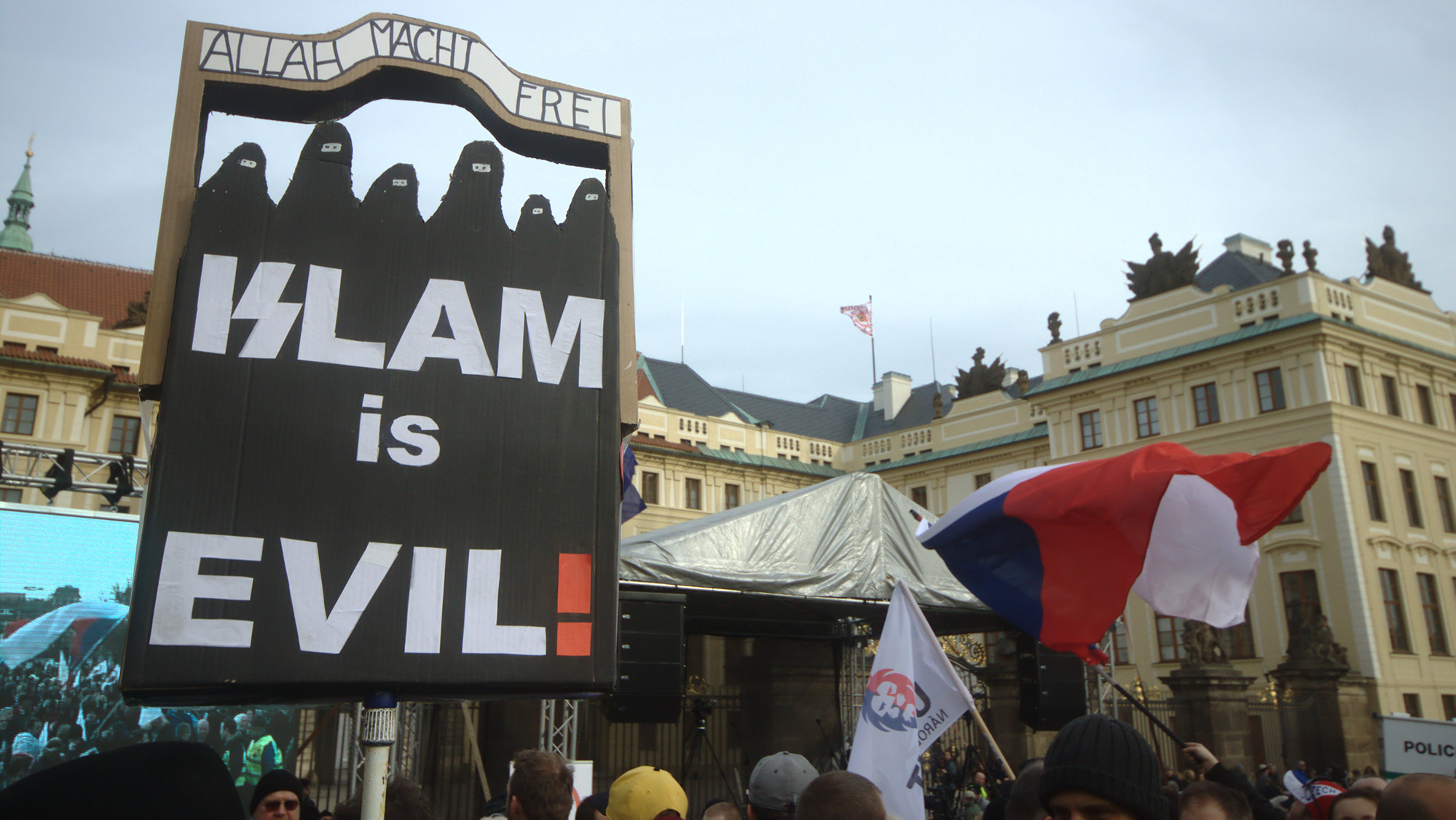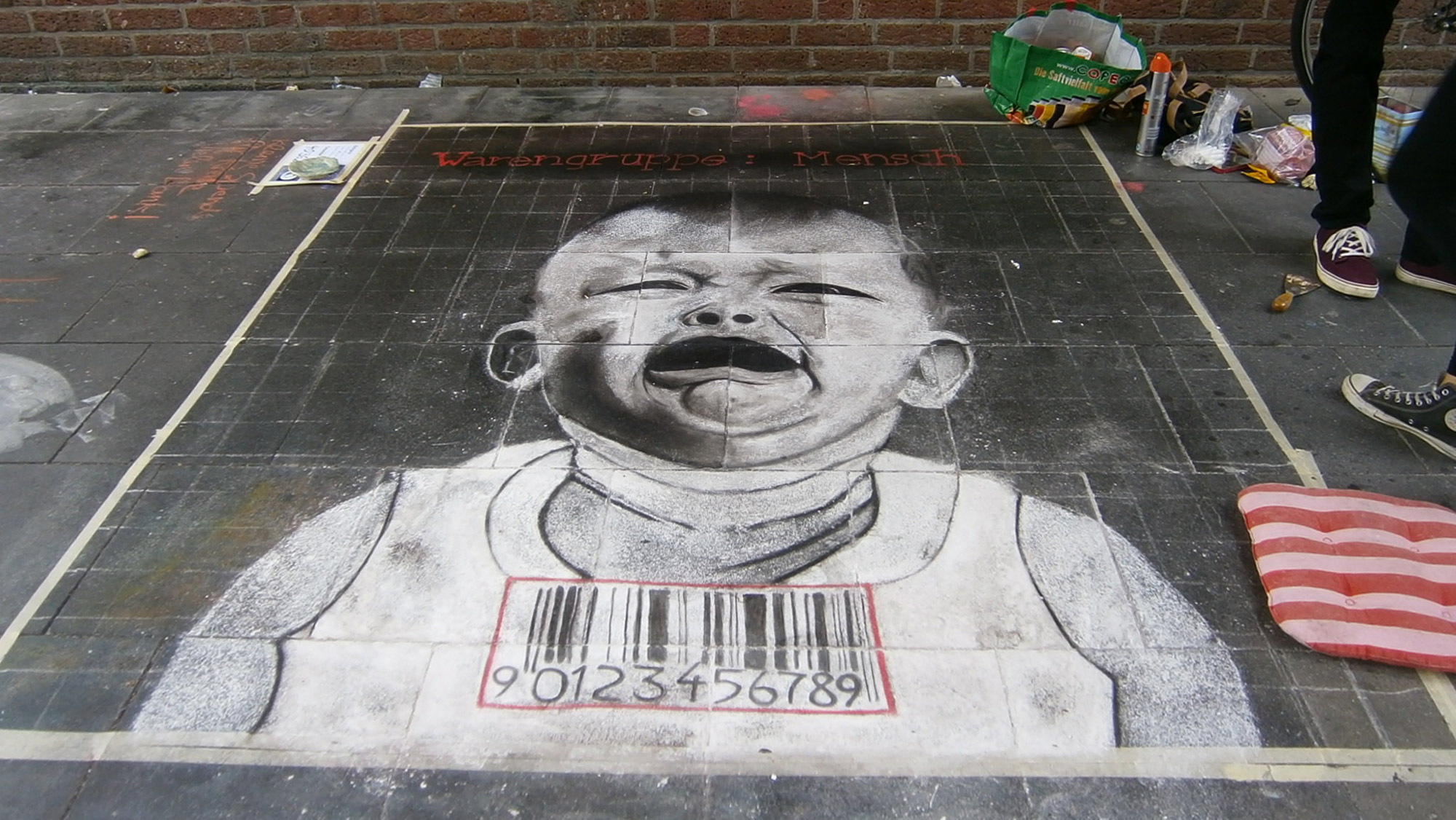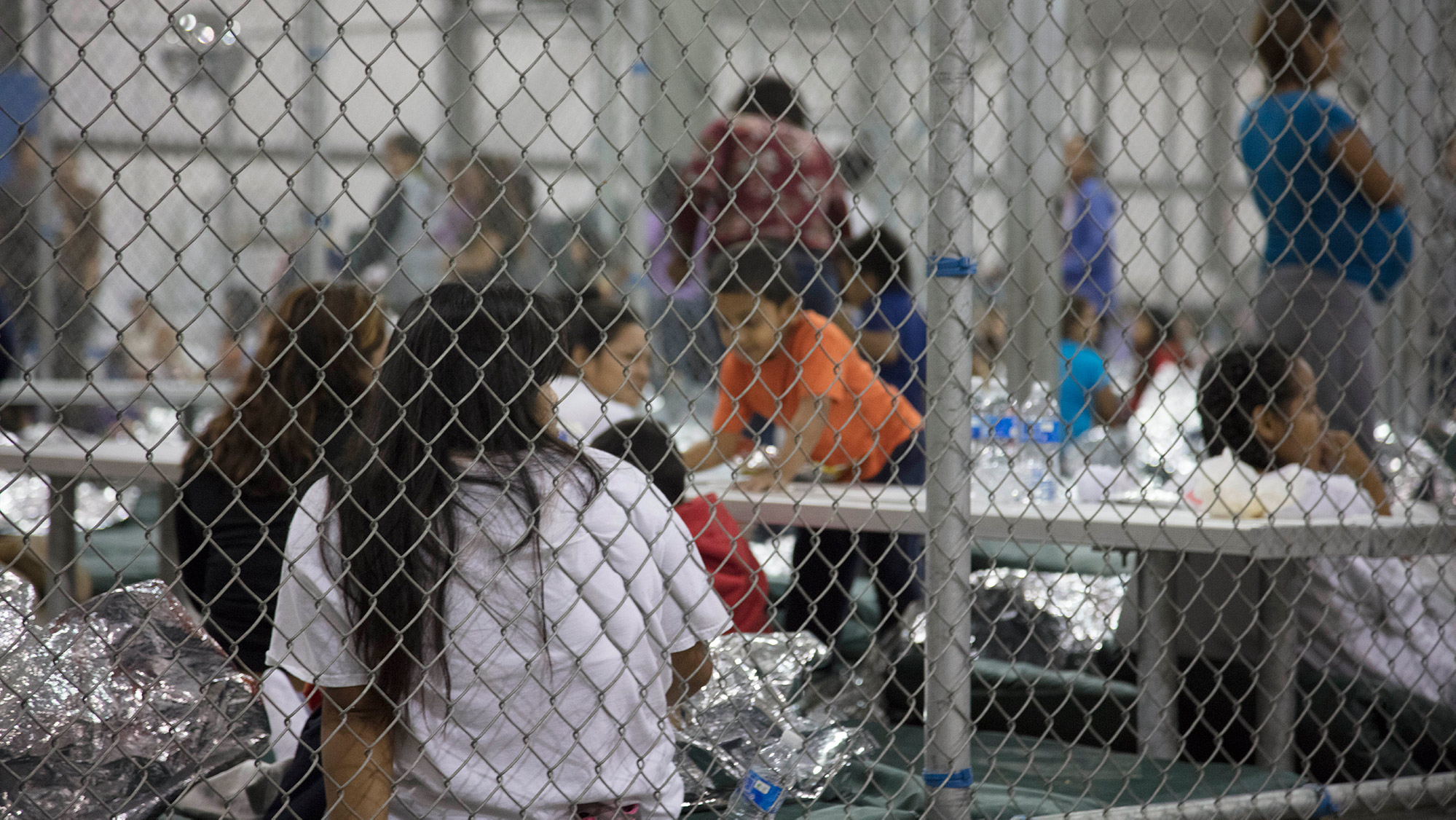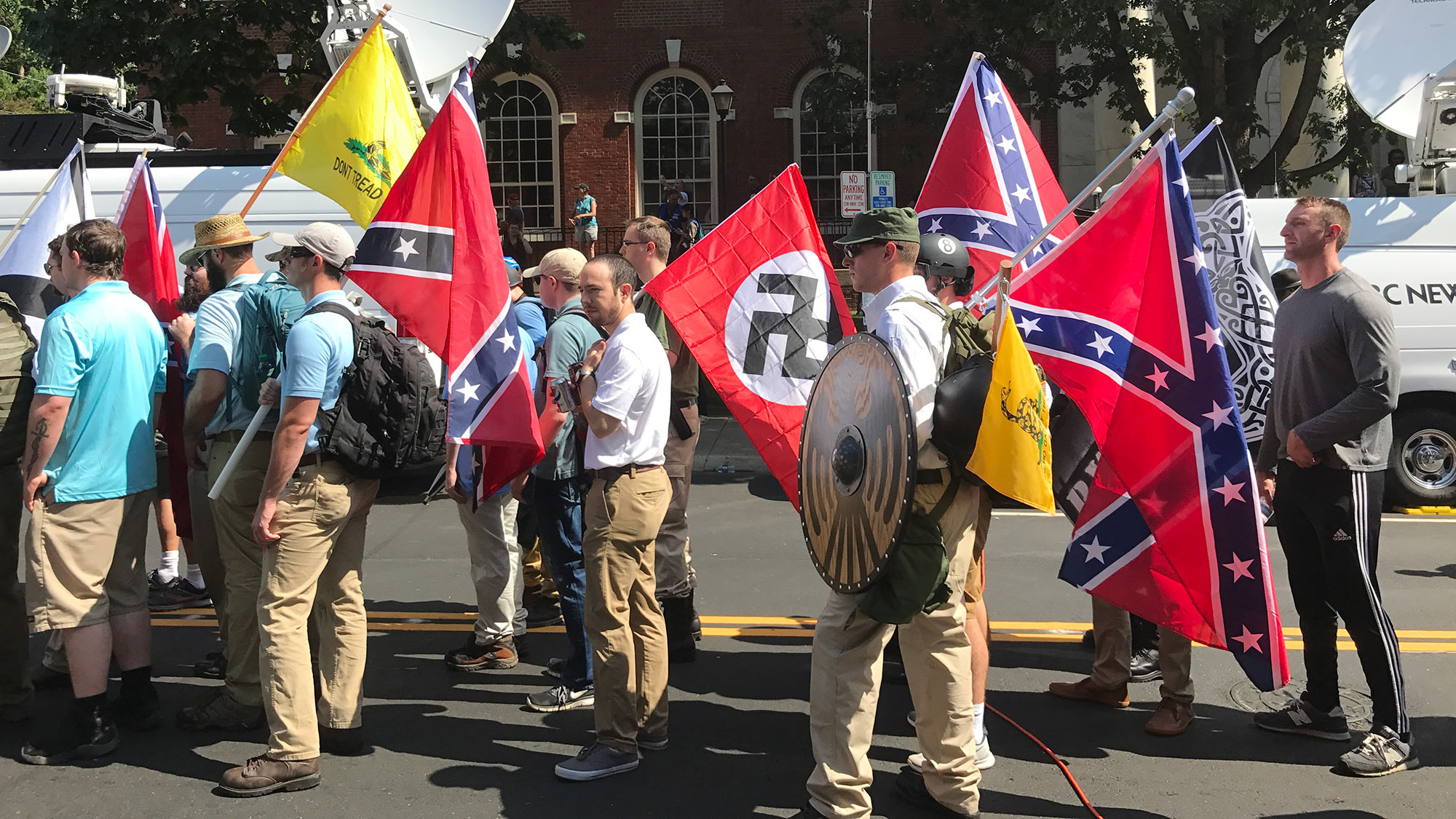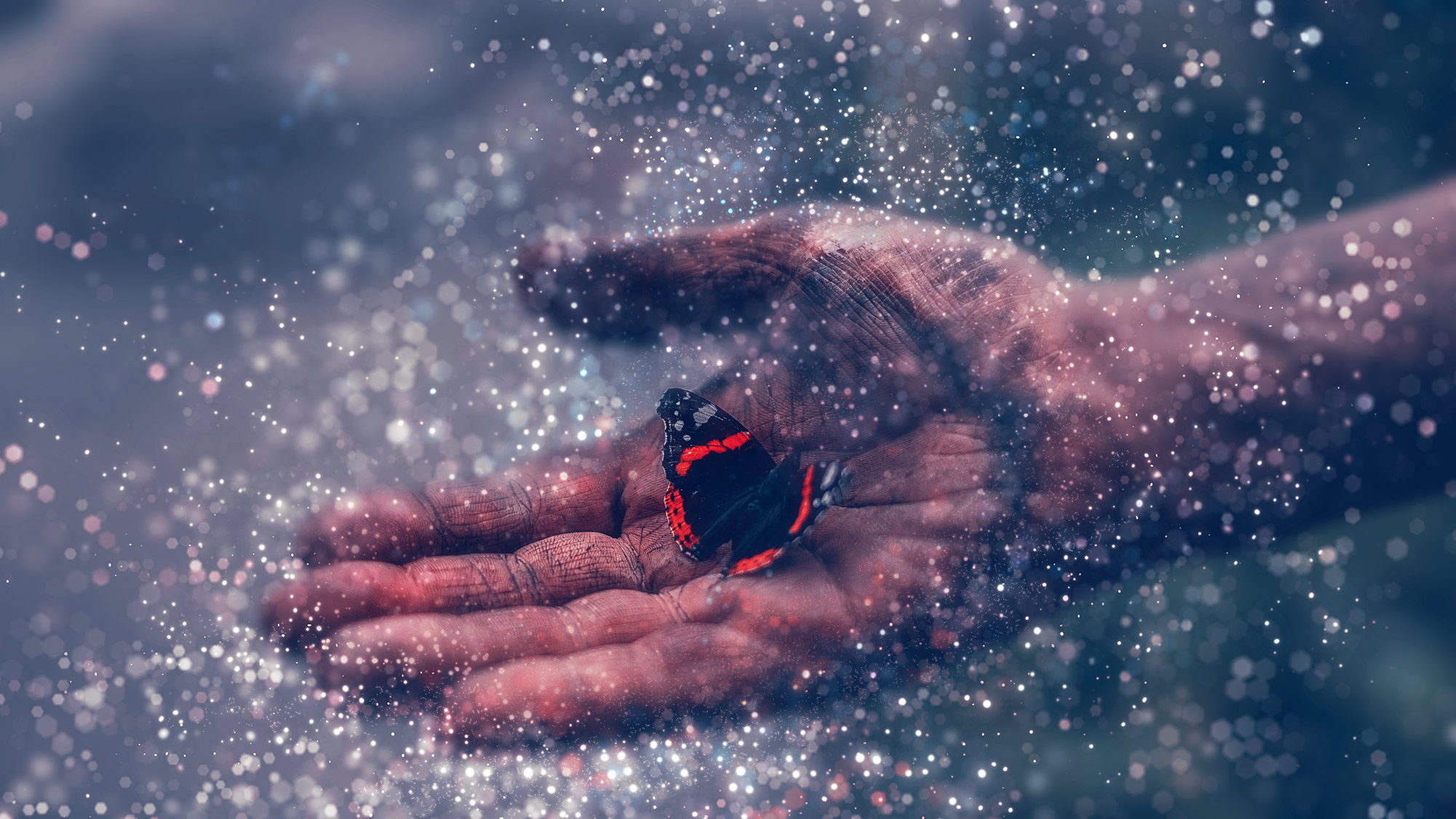Dread: The Politics of Our Time
A Symphony for Dread
I
The election of a sitcom to the American presidency grounds both our fascination and our dread. We awaken each day to a question about each: what’s the next episode, what the horror facing us now? In fact, they turn out to be the same question. Dread is a function exactly of this mixing of genres, of their indistinguishability. We can no longer draw the distinction. We are, to borrow a phrase, “phenomologically fucked” (Abramovich).
It has been a struggle to put our collective finger on the feeling of this moment, the gnawing sensibility of our time. Political depression is too common to capture it. One gets politically depressed in the face of losing an election or vote, say. But that tends to pass more readily, when one re-commits to the struggle to ensure a better outcome the next time. There is some of that currently, to be sure, but this seems deeper. It is not a momentary passing of a candidate or world historical caricature with whose commitments one basically disagrees. Political depression may cut more sharply in one cycle or another, depending what side of the issues one is on. But there is something else at work now, responding to larger, more tectonic shifts.
Where indistinction becomes generalized—between war and peace, everyday practice and corruption, desire and demand (or command), between work and recreation or work as recreation and recreation as work (or a work out), between human and technos, the next ecological disaster and the next five-minute news cycle—dread has become a driving affect of our time. Prolonged dread is the mark of this moment, of its seeming inscrutability, its illegibility, where the improbable has become likely. We rationalize repeated raging hurricanes and the quaking earth as acts of nature. But like famines and floods the destruction they wrought are invariably anthropocenic. They are prompted and enabled by human shortsightedness, inaction, overaction and overreaction, or instrumentalizing intervention. Dread drips from the pervasive sense that incomprehensible extinction could strike in a blinding second.
War machines increasingly came to drive the economy of twentieth century modernity. The world went from machine weaponry and automobility to aircraft, atomic and nuclear destructiveness threatening environment and existence alike. A new generation of war machines has marked neoliberal and now trans-neoliberal capital.
We are losing the ability even to name precisely the fast-evolving predicament of our moment: endo/post/trans. The impact of these war machines now proliferates throughout everyday life: automatic weapons, drones, gps, driverless vehicles, face recognition technology, stealth technology, and so on. Today, war—like work—is becoming increasingly roboticized. Drones are the first step. AI driven warfare—the managing of, strategizing about, and increasingly the execution of war—is fast developing to the point of autonomy, of algorithmic self-definition. Like automobiles and financial transactions, war machines will soon fully operate themselves, making auto-generated decisions on the basis of data inputs and reiteratively calculating formulae. Affect seems nowhere to be found, formulaically squeezed out, save when it unexpectedly returns to haunt.
The algorithmic is quickly becoming the mode not just of production but of sociality. Its modus operandi—its operating logic—instantiates and deepens the increasing inscrutability of the logic of production and relationality. By extension, this imperceptibly curtains off the loss of control as both sensed condition and factual outcome. Hence the contemporary concerns about transparency, self-determination, and sovereignty.
The triangulation of unpiloted technological targeting, acceleration (for instance, North Korean nuclear capacity), and loss of control intensifies dread. The benefits of these war machines pervade and consume our everyday functionality now, further blurring the distinctions. Much of common technological prowess has roots in military R and D, from automobiles to computing technologies, energy efficiencies to clothing.  We can now speak with some accuracy of “warpeace” proliferating to the point of indiscernible low intensity wars or microaggressions, law enforcement, even recreation. Games of war and war games are not so readily distinguishable. Slow violence and not only of the ecological kind (though that too) pervades everyday life.
We can now speak with some accuracy of “warpeace” proliferating to the point of indiscernible low intensity wars or microaggressions, law enforcement, even recreation. Games of war and war games are not so readily distinguishable. Slow violence and not only of the ecological kind (though that too) pervades everyday life.
We live now not only in a constant state of war, but of its more or less undiminished and continual dread. This includes the dread of its outbreak, of its conduct, of its violence, of its effects, of its costs. Of war as such, conventionally comprehended, but more generalizably of a war (the indiscernibility of the indefinite article indicative of the proliferated insecurity) on everything: on poverty, on drugs, on crime, on the environment/nature/the climate, on neighbors, on immigrants, on refugees. We have come to live, then, in proliferating dread, even of dread itself.
II
There is a conceptual distinction to be drawn between wars over resources and wars about forms of life. Many wars of course involve an interactive dynamic of both elements. Civil wars tend to be thought of generally as internal to states, but in so far as they combine the drive to exercise control over resources and how to be in the world, they don’t simply stop at the border. Civil war has morphed from the politics of extreme exception or occasional outburst to that of the commonplace, the everyday. It is the point at which politics and war are indistinguishable. Civil war is no longer the end of politics but its normalized expression. It is overdetermined too as a function of social inscrutability in the name of transparency, and proliferated paranoia, unsafety, and insecurity in the service of the technologics of security. More than half of high school students in the US today (51 percent) are reporting stress and anxiety, much of it racially and gender driven, up from just seven percent in the years prior to Trump’s election (Tareen). The agitation is intensified, even exaggerated, first by the proliferating threat of gun violence and then by the incessant social media engagements making up everyday life, and in the case of youth pretty much of every waking moment (Beauchamp).
Socialities find themselves slipping into civil war when within or between them they are wrought by irreconcilably contesting conceptions of life. Living for the state’s inhabitants is largely made unbearable. Those at least nominally controlling the state apparatus insist on obedience and deference to its way of being, on pain of erasure for refusal or resistance. Civil wars become struggles over competing ways of being in the world. They are struggles over their underlying conceptions, ways to live, and over control of the state and its apparatuses to materialize and advance these commitments.
Colonial existence, as Achille Mbembe has noted riffing off Fanon, is a permanent state of agitation, a state of constant alarm. These are constitutive conditions of coloniality, not just by-products or occasional affective states in colonial societies. The sovereignty of colonized states was always in question. Globalization has updated and heightened this alarm by blurring anew some aspects of the boundaries between states, drawing into question the absoluteness of even metropolitan state sovereignty. As state sovereignty has frayed at the edges, if not eroded altogether, social conflict has gripped state culture, within and between states. State force is insisted upon where sovereignty is deemed under duress. Where politics is indistinguishable from civil war, dread has become its leakage.
In a world with no more transcendental gods and the unleashing of generalized uncertainty, race, as I have argued elsewhere, is the secularization of the religious. God is dead, Marx is dead, and I’m not feeling so well myself, as Ionesco once put it (there’s a pop song now too with that chorus, indicative of the condition’s generalizing from high to mass sensibility). If religious experience once purported to be about spiritual enchantment, the implication of Ionesco’s pithy insight is that today the politics of religion seems driven by disenchanted resentment, often taking on an apocalyptic articulation. Post-apocalyptic survival looms as large in this cultural imaginary and its commercial materialization as post-life ascendancy, from survival training and entertainment programs to exobiology investigations.
Religious wars, historically marking the European landscape, now are nothing short of race wars, internalized: about self-proclaimed origin narratives, about make-believe kinship (not so long ago widely and explicitly called “blood,” reiterated today by the hot whiteright), about the landscape and its ownership, about access and privilege, about control and its subject(ion)s over resources and decision-making, truth claims, facts and evidence, about cultural legacy and its parental provenance. Which is to say about its heritage. But also about its “proper” inheritance, its rightful heirs in whose name the culture will supposedly live on as defining traces, even while being remade. “Blood and soil,” all “ours”, as the Charlottesville marchers chanted. “We will not be replaced.” At their core, then, civil wars are about control and belonging. The intersecting and interacting epistemological and ontological powers of (self-)determination and (co-)being. Brexit, Trump, Generation Identitaire, and AfD are all leading manifestations of these deeper twists, the symptomology of their waning.
The line keeping outsiders out operates in terms of the racial determination of immigration, and the technologies of segregation and bordering, internally as much as at the outer bounds. In Europe’s case these racial determinations reach across the lines of the historical and contemporary, the religious as racially instantiated: Jews, Muslims, Arabs, Blacks, Roma, Asians and South Asians. In America’s: Mexicans and Muslims, and Blacks and Jews if they had their way fully. The line marking insiders as not fully belonging is inscribed in terms of differentiations in blood, bones, and behavior, culture and character, projected incapacity and lack of intelligence. The preclusions are enacted in the name of maintaining historical homogeneity in the face of its undoing.
But the maintenance—first of the fantasy of differentiated being and capacity, and then of its enactment—is possible only by the compulsions of make-believe. This conservation requires force and forced constraint of thought and deed, of compelled movement and sedentarism. Temporary encampments and border walls perhaps collapse the two. “One way or another,” Trump has repeated misleadingly, “Mexico will pay for the wall.”
A couple of points need stressing here. That the homogeneity needs to be maintained speaks to its artifice. Presumed the natural, the default state of social being, it is anything but. And that maintenance requires force, intrusion, fraud. “Make-believe” brings force and fraud explicitly into play with each other in its drive to realization. It requires repression, if not a purge of the supposedly polluting ideas and then the people who are drawn to them. The racial wall, whether ideational or material, is either material expression or outcome of the social warring at work. It is at once symbolic of the boundary lines and cementation of who is made to be a welcome social member and who lacking social standing, even as (fully) human.
Consider, as one example among many, France’s Generation Identitaire. This group has created itself effectively as a youth millennial alt-right corps. It produced a video entitled “Declaration of War.” https://www.youtube.com/watch?v=kqybsUqkOWs “We are the generation of the total failure of coexistence, and forced mixing of the races. We are the generation doubly punished: forced to pay into a social system so generous with strangers it becomes unsustainable for our own people . . [and] the victims and the May ‘68ers who wanted to liberate themselves from tradition, from knowledge and authority in education. But they only accomplished to liberate themselves from their responsibilities.” They continue: “We no longer believe that “Khader” could ever be our brother. We have stopped believing in a ‘Global Village’ or the ‘Family of Man’. Our heritage is our land, our blood, our identity.” Declaring themselves to be “victims . . . of an explosion of anti-white racism,” they conclude “This is a declaration of war”. The alarm is no longer the occasional fire drill or ducking for cover during nuclear preparation exercises. It is today the constant ringing in the ears.
So it is less that the phenomenon of “Trump” or the European equivalencies represent change than that they do an unleashing. Forces that Trump’s campaign itself tapped into instrumentally to get him elected were already fueling the general culture. They far outstrip Trump’s—or any individual’s or party’s—control, or urging, or even shaping. These forces unleashed also the associated resentments become enmity, to use Mbembe’s characterization. They have made (more) thinkable once again a drive to absolutize a social order of homogeneity, of antagonism to those taken not to belong, constitutively, constitutionally. And in their—your, our—non-belonging to constitute a threat to those insisting the society and affiliated state resources are theirs alone. These forces are proliferating in the US and across Europe, in Australia, South Africa, and India. There is a ramping up of a social order of the new (totalizing, global) enclosure act. It is a closing off to the different, a pushing out that can only be effected, in the final act, as a politics of purification. Conservative political coalitions in Italy are explicitly committed to maintaining a “pure race” and that, in the words of one candidate, immigrants threaten the survival of “the white race.” Attilio Fontana added, in Corriere della Sera, Italy’s leading daily, that his “racist views boost his popularity.” (The shooting rampage in Central Italy in February 2018 targeting African migrants, wounding six, was by a candidate of this coalition in local elections, in whose home was found a copy of Mein Kampf.)
There is a seeping realization, then, that we really are in a new time, not just in the US but globally. This moment perhaps was initiated by the political forces of the 1980s and cemented post 9/11. The emergence of HIV/AIDS, the “war on drugs’ and the crack crisis, the undoing of the caretaking state and the rooting of neoliberalizing policies promoting social abandonment, the associated attacks on affirmative action and positive discrimination programs, as well as the erosion of privacy and the heightening of intrusive surveillance. Over time these dynamics coalesced into the death, the killing off, more recently of multiculturalism (in the descriptive sense in which Stuart Hall used it) as representing a social life of the mixed and heterogeneous. And this in turn has manifested in recent years in the logic of political postraciality: the unleashing of the forces of political and social erasure, the purification political drive, in the wake of the conceptual erasure of the language of race by which to identify the resultant wrongdoings. The analytics of race and racism have steadily given way to that of “hate,” as if what is happening is only prejudicial, and at worst the individuated eruption of unbearable psychological baggage.
Dread marks the gnawing sense that in the unleashing of these (re)new(ed) forces a disturbing and dystopic social condition is seeping virally across the planet. It is absorbing increasing regions and people into its force-field. And it sets the terms of (dis)engagement, forcing the forces of the counter onto the terrain of its articulation, in a word of warring too.
https://twitter.com/OccupyOakland/status/827007309922476032
Dread has a habit of creeping up on us when least expected. And when it does manifest, like the slowly spreading desert imperceptibly absorbing into its shifting sands more and more of the earth’s surface, we tend to be in denial both of the occurrence and the causes. Take, for instance, the protagonist in Omar Fast’s remarkable video, 5000 Feet is the Best.
A US military drone operator based in the Las Vegas suburbs identifies and takes out human targets in the deserts of Iraq and Afghanistan. At five thousand feet, he insists, he can identify the brand of cigarette his target is smoking on the ground, the color of the shoe laces he is wearing. He has a god’s eye view. He is god, holding in the press of his thumb the power over life and death, the exact moment of obliteration. He is giddy with his divine power, his absolutized sovereignty.
Until he is not.
“The nightmares began.”
Dread crept up on him as he stealthily crept up from on high, from worlds away, on his unsuspecting target turned enemy.
Dread now is literally at the door, in the home. Colonial agitation has become replaced by post-political (I am tempted to say post-historical) melancholia in the Lars von Trier mode. It is not that political dread has no precedent in taking hold to some degree of those in a society. Perhaps there was something of this sense across especially Central Europe between 1933 and the outbreak of WWII. But dread did not assume the sort of global reach we see proliferating now. “Waiting for Godot” today anticipates the apocalyptic constantly deferred to just in time delivery.
How then to understand dread and the politics it conjures and promotes?
III
For Kierkegaard dread as a psychic or affective condition or state is produced in the face of Nothing—by not-being, by non-occurrence, by absence. Kierkegaardian dread arises from the absence of the possibility of forgiveness for or redemption from sin should God fail to exist. Less like fear and more in keeping with melancholia, dread has no defined object. It follows from lack: of possibility, of predictability, from denial of principle. Where even the known unknowns are obtuse, are unknown (unknowns), precisely there the emptiness is filled with dread.
Dread emerges out of an unpatchable tear in being, existential or social. Dread always seeks out that which will increase its own velocity, deepen its hold, magnify its unsettlement. Dread is enigmatic: one can’t quite put one’s finger on it. One cannot even define or identify the feeling that is dread itself. It is neither sadness nor happiness. The affect of dread is unfathomable torment. Dread is depthless, bottomless, lacking insight. It is an agony with no single definable object giving rise to it. It expresses a general anxiety the prompt of which is indefinable, a nagging sense that has no singularly compelling explanation. Dread freezes out all other feeling. It is world-surrounding, world-infusing (cf. Blanchot).
Hortense Spillers has commented that “actual power” produces fear; “symbolic power” does not necessarily as one “can take it or leave it”. Expressions of symbolic power, I am suggesting, are more likely to unleash dread. Dread is phobogenic, in the Fanonian sense. The nagging dissatisfaction and anxiety lacking any materially identifiable prompt or cause is displaced onto targets of opportunity. The most vulnerable, least accepted, the perennially nonbelonging become the objects of mounting violence. Last arrived, the most powerless, the first despised. Vulgarity and violence, bigotry and brutality against the vulnerable become the bitcoin, the stealth cryptocurrency, of the politics of dread.
An Uber driver, a young Black man, picked up three white barely twenty-somethings, two men and a woman. As he climbs into the back seat, one of the men exclaims, repeatedly, “white privilege.” The fragility of its claim requires repeated insistence, as if only for self-assurance in the face of its relentless doubt. The driver remaining outwardly calm quietly asserts his authority. The insulting man asks for music, the driver refuses. Both male passengers keep touching and moving contents in the car. The driver, his voice even and firm, his disposition respectful throughout, asks them to return the contents to their rightful place. The woman tries to talk her two friends out of their racial belligerence, at least for the length of the ride. A few minutes along the way, the driver pulls over and orders the passengers out. As the more belligerent man exits, he erupts: “You’re one fucking bitch-assed n*****.” The driver, anger mounting but in full self-control, exits the car too, then dresses down the man non-violently (he is clearly better than most of us). As he returns to the car, he first addresses the explicitly racist person: “Be thankful that I’m a calm collected dude”, and then turns to the woman by name (she ordered the ride): “Rebecca, that kind of mentality, if you are not like that you should stay away from people like that”. He drives off, retaining his enormous dignity throughout.
This makes obvious the racial dimension to the elaboration of dread, as Achille Mbembe paves the way to seeing. When Europeans “see” a black man, Mbembe remarks in Critique of Black Reason, they see “Nothing.” The point is generalizable to whiteness at large. This is, as he puts it, the delirium or mania of race. If delirium produces manic expressions, invariably violent, dread tends to fixate, to fix in place, to render the dreading subject immobile in the face of the dreaded. Delirium and dread dance together—a dance macabre—in the production of disaster. Death is the inevitable end of this dance.
When police in the US are accused of shooting without provocation innocent Black adults, especially men and boys, they invariably offer the defense of “fearing for their lives.” Almost the only criminal case in which this defense has failed to hold up concerned the shooting of Walter Scott. An unarmed Black man, he was shot in the back multiple times. The policeman was sentenced to twenty years in prison. What fear exactly would a well-armed US policeman suffer in facing the back of a Black man fleeing from him for his own safety? In point of fact, what better accounts for such violence is that the officers are less in fear than in dread of a whole population of Black people socially demonized to the point of dehumanization. “The dread of the Negro,” as James Baldwin puts it in his notes on Medgar, Martin, and Malcolm, or by Israel and its supporters of Palestinians. Not of any specific person, nor any actual acts of identified people, but abstractly of “the Black” or “the Palestinian” or “the Arab” or “the Muslim” as such.
Generalizing this, we find ourselves globally—as the very outcome if not condition of the processes marked as globalization—in the historical conjuncture of a demographic tipping point. I don’t mean this in the sense of the 1970s anxieties about the “population bomb.” As with global warming and climate change, we are deeply into the transformations—demographic, cultural, economic, technological—of which these population shifts serve as the more visible edges.
US Population Projections by Race/Ethnicity, 2016–2060
The demographic tipping point conjuring such deep anxiety is that of proliferation itself: of mixtures and their manifestations, entanglements and their entailments, of the intensifications of these transformations where borders, boundaries, walls, and divisions are hardening as impossible resistances to the processes deeper and more profound than they are able to hold off.
Alain de Benoist, one of the intellectual progenitors of today’s white nationalism, has denounced “left-racism” as leading to the “homogenization of the world.” Erasing ethnic differences, he charges with no argument or evidence on either side of the hypothetical, would lead to “ethnocide,” the “disappearance of ethnic groups as ethnic groups.” His worry, the worry of white nationalists, is the obliteration “of the right to difference,” of the “right to live with one’s own ethnic kind,” of self-consorting only with Europeans or whites (Feder and Buet; cf. Papenfuss).
The paranoia represented by this “ethno-differentialism” is produced by the dread of the unknown, of what might become of one’s life once control is lost, power foregone or foreclosed. The dread of a future “overrun” by those taken to be “not-us,” those not sharing a way of life, common values, common sense. The dread of a Black-Brown-Muslim Planet.
Those identifying as white and with whites experience dread in the ways characterized here. By contrast, Blacks suffer dread—and in whiteworld have pretty much always—as a lived condition of their constraints. The dread takes on the specificity of fear as the prompt hardens into palpably identifiable objects of concern. The always possible police stop and frisk, the official knock on the door, a burning cross on the lawn, the cleaving asunder of families. The racist remark out of nowhere followed almost inevitably by the denial of its racist intentionality, the silent presumption of white innocence and Black guilt. The less overt codes, the structural impediments and institutional barriers, the taken for granted belonging and entailed occlusions. The fears of those constituted as not white are set in relief against a canvas of accumulated experiences; the dread of self-defining whites is predicated overwhelmingly on make-believe.
Dread, in short, envelops. It inhabits the world it comes to constitute, to define. That world, the “dreadsphere,” becomes at once, and interactively, dreadful and dreaded. So much so that the dread itself becomes preoccupying, all-enveloping, claustrophobic. We have shifted, perhaps, from the condition of planetary fear (what Virilio calls “cosmic fear”) in the wake of Hiroshima to planetary dread today. Planetary dread, I am suggesting, is unleashed and licensed by globally distributed forces ranging from weaponized destruction to viral technological displacement, cross-generational and constitutively gendered sexual molestation and violation, soaring precarity for most with outlandish wealth for the few, and a rampant politics of alienation, elimination, erasure.
Dread is the sense that there is no truth in the matter, nothing to know or grasp. Dread trades on the reduction to absolute absence: no-knowledge, no-truth, non-relation, nothing left to lose. Dread, in short, is unspeakable. Or more precisely, the urgent reach for a truth incessantly evaporating. Dread is, to pick up on Virilio’s compelling characterization, a “community of emotions,” a “communism of affects.” Where dread privatizes the affective, isolates it as discrete individualized feeling, all that is left to this communality of feeling is pure futility.
Modernity’s drive to conquer the unknown as both knowledge and political (colonizing) projects has been displaced by the reiterability of unknowability. Cartesian doubt as the underpinnings of the epistemological drive has given way to proliferated doubt as political project: the refusal to know as power/ignorance. The power of ignorance is brandished as a blunt weapon, a refusal to know as a way of getting away with murder. Climate change. Nato’s relevance. Foreign meddling in local elections. The costs of health care dis-insurance. The increase to the national debt of tax reform overwhelmingly favoring the wealthy. Men’s rapacious sexual transgression and violence. The social costs of spiraling inequality. The economic benefits of immigration. Political corruption. History itself. (Trump credits himself—he doesn’t hide the fact—for having never read a book. Think of that. No history, no accounts of previous presidents or global leaders, no Lao Tzu or Clausewitz or Shimon Naveh. No Lincoln-Douglas debates or Frederick Douglas or Harriet Tubman or Martin Luther King, nothing on the impact of war or hunger or the lack of medical coverage. No Machiavelli, for all of it. He hasn’t even read The Art of the Deal, which he didn’t write. The proud know-nothing. A presidential illiterate.)
IV
The world has moved from the financialization of everything (under neoliberalization) to the rapid datafication of everything (algorithmifying and appifying life at large). In this rampant datafication proliferated by platform capitalism determinations are replacing choices. Consider the advertising feed incessantly into browsers and increasingly into “personal” online clients like email and social media accounts based on current search and communication patterns. These developments, along with pervasive surveillance, point in turn to the collapse of privacy for any reason other than the attribution of personal responsibility. Smart phones not only enable generative interactivity; they are also ubiquitous tracking devices, monitors of desires, demands, interests, movements, interactions. Modernity’s “homo deus” (as Yuval Noah Harari characterizes the turn), where man assumes or aspires to godly status, has given way to “post-ality’s” “homo datum,” reducing humans to sets of data points. The use of Facebook data by companies such as Cambridge Analytica created voter profiles in a widening range of global elections. Humans amount to nothing more than information tranches. AI steps into the breach of this reduction, assuming deific qualities. Dread in this moment comes to express the mo(u)rning of the pending erasure of human trace.
On these assumptions, raciality likewise amounts to no more than a collection of data points. As such, racially driven concerns assume social traction only in so far as they enter into the preference schemes of social actors. And preference schemes are increasingly shaped by intrusive algorithmic feeds. Algorithmic embedding of racially coded presumption and unequal impact denuded of explicit racist expression represents the perfect postracial discriminating machine. Where all that would stand in the way of racist expression would be counter-racial preferences, little but dread is left to fill the political void in the abandonment of normative assessment and critical counter, reparation and reconstruction.
Dread under these conditions is an invested antipathy: the affect of the nihilistic. A digital “error” message: “The system has detected existential dread. Nothing to be done.” Agency is frozen. This predicted erasure and extinction or at least irrelevance of human agency follows from algorithmic self-liberation auto-coded to produce its own possibility. The ontology of the algorithmic combines its identification as futurology with its future as the ontologically all-consuming. Everything now falls under suspicion, including claims of or by governmentality. Skepticism has given way first to denial and then to fabrication, to denial as the gateway to make-believe. It’s not so much that anything can be true. It is that truthfulness itself has become so denuded of value that pretty much anything can be assumed to fill the void left in its wake. Truth is just another word for nothing left but make-believe, to update Janis Joplin.
In this suspicion of any and all truth claims, they are deemed optional tout court. Truth claims have been reduced to one among the immediate possibilities. Truth is activated only as another bullet in the arsenal of make-believe opinionating. Alt-facts, alternative truths, and alternate realities have become the porous ontology of our moment. One simple example, at once everywhere and nowhere: “Make America Great Again” caps, themselves declarations of the civil war striking across the land and planet, tend to be made anywhere but in their place of declaration. Vietnam seems to have acquired the largest contract, no doubt at the lowest cost because produced by labor paid less than a living wage. The site of America’s great lost war has been turned into that of its fabricated resurrection by a President who went out of his way to evade conscription. The political theology of make-believe has but dread at its core.
Dread is prompted and sustained by destruction or its threat: the destruction of norms, especially ethical norms but also more generally social and political ones; of reality or truth claims within a regime of truth, or indeed of the regime of truth itself; the destruction of hope. Here hope—of a better tomorrow, of things moving forward, of possibility—does not erase or even postpone dread. Rather, dread moves to an elsewhere and otherwise, displacing and extending the abiding anxiety in contemporary circumstances about the to-come and to-be, or their unachievability. Where “greatness” amounts to the capacity for unbridled self-assertion, “Making America Great” conjures an apocalyptic nuclear war, rampant poverty and inequality, accelerated global warming and catastrophic weather events, and so on. Acceleration has collapsed time and space to the point of instantaneity, to the here-now, economics to algorithmic calculability, (chrono)politics to eventfulness. The more instantaneous, the less controllable, the less regulable, heightening anxiety in the face of instantaneous futurity for a governmentality predicated on sustained domination and control.
Take, for example, a Trumpeted signature tune. Throughout his candidacy and since, Trump has stressed work as work disappears in the wake of the joint forces of financialization, globalization, and robotification.  If, as projections suggest, sixty percent of work will be robotified in our time, then one of three possibilities follow for social futures. The workless will get to enjoy a non-working life by way of a living wage—or guaranteed job, as economist Stephanie Kelton has proposed—underwritten by wealth generators. Or unpaid work—care work, service work, charitable work, and so on—gets redefined as waged labor. Or, the most currently evident, there would be no work for the spiraling unemployed other than soldiering, for children as much as for adults. The work of war. The stress on work when work disappears leaves only distress.
If, as projections suggest, sixty percent of work will be robotified in our time, then one of three possibilities follow for social futures. The workless will get to enjoy a non-working life by way of a living wage—or guaranteed job, as economist Stephanie Kelton has proposed—underwritten by wealth generators. Or unpaid work—care work, service work, charitable work, and so on—gets redefined as waged labor. Or, the most currently evident, there would be no work for the spiraling unemployed other than soldiering, for children as much as for adults. The work of war. The stress on work when work disappears leaves only distress.
The politics of dread is evidenced also in the drive to curb or end (im)migration as global movement is unleashed. Generation Identitaire bears this out. It sees, in the extreme, nowhere to go but to war. Like their French counterparts cited earlier, members of the Italian chapter are “waging war” explicitly against African migrants at sea. Hiring dinghies, they are launching into the Mediterranean to prevent African migrants landing on Italian soil. Be free, join the army. (Ironically, the military are seen here—indeed, project themselves—as peacemakers while proliferating informal armies or private militias increasingly insist on a call to arms.)
Stress and distress, the stress of distress, of seeing no option or outlet but a call to arms, has other exemplifications too. Call the police to attend to an assault taking place just outside your home or get stopped on the street for minding your own business. One is just as likely to lose one’s own life to a police bullet or strangulation as one is treated as a danger to police lives in answering the call. Or a waste of their precious time they could be using more profitably to collect debt from others, while at least in some places you were resisting paying them off to leave you alone. The more so the more one is recognized or mistaken for black, identified—that term again—as criminal, as threat, as disposable. Black folk are the perennial canary in the coalmine, and far from only in the US: what can policing, ruling, warring get away with? Where there is little resistance in the social experiment to black maltreatment, then it is but a short step to applying that treatment to others deemed threatening or burdensome or simply resisting authority.
Now indebtedness is the proliferated condition of being today. I am in debt, therefore I am. Those without capital assume value only by taking on debt. But the more deeply I am in the debt I have been urged to take on (individually or collectively) to the point of defaulting, the more readily my being is discounted. Those who were underinsured in losing their homes to Houston’s Hurricane Harvey or Puerto Rico’s and Florida’s Irma may receive just a fraction of the needed replacement costs from government support. They are left to go further into debt simply to reinstate a roof over their heads. The very ground of my being is the logic of my unbeing, my undoing. Austerity is financial droning. War is continued, as Lazzarato and Alliez comment, through debt. It is not “like being in a war;” as the say, “It is war.” Postcolonialism has been superseded by “endocolonization,” to riff on their term. This amounts to the new “internal colonization” drilled down, given Foucault’s conception of governmentality, into the body itself. Auto-generated—algorithmic, appified—house arrest. The bar-coded prison house of self-immobilization.
Indebtedness is nothing short of indreadedness, the logic of our times. Where the social has become defined totalizingly by “divisions, dominations, exploitations” (Lazzarato and Alliez), social subjects have nothing left to lose but their dread.
V
Is dread a political concept? Does dread signal a politics? What might political counter-mobilization look like? Are flash mobs the characteristic political analogues of dread in the contemporary moment? Terrorism, it could be said, is the sole possibility left with everything to dread and nothing left to lose. It is, perhaps, the death—or at least a symptom of the death–of even the possibility of politics.
Afro-pessimism projects itself as the radical counter to the assault on blackness, and at least implicitly to the condition of indreadedness itself. Afro-pessimism is predicated largely on a single insight, concerning constitutive violence to the point of social death against Black people. The claim is mostly overgeneralized and, as Nick Mitchell shows, partially and inconsistently theorized.1 Blacks—Afro-pessimists make the claim to speak of all Black folk anywhere but predicate their claim on the projection from African-Americanity alone—are constitutively, metaphysically, subjected by the white supremacy of capitalism to social death, to gratuitous violence, ultimately to death itself. In the words of Afro-pessimism’s principal architect:
“The antagonism between the post-colonial subject and the settler (the Sand Creek massacre or the Palestinian Nakba) cannot—and should not–be analogized to the violence of social death; that is the violence of slavery, which did not end in 1865, for the simple reason that slavery did not end in 1865.”
Blacks, and only they, exceptionally suffer the extremity of the condition. Native Americans and Palestinians, like European settlers, apparently have “somewhere to return as Human Beings,” a homeland of one kind or another (Wilderson). Blacks, apparently—again, the claim makes any sense at all, even in its generalized confusion, only on the assumption that by “Blacks” are meant Black Americans—have none. Black life as social death is constituted as exceptional in much the way that genocidal experience tends by many to be presumed so as the defining condition of post-Holocaust Jewish life today.
Dread collapses distinction and analytic nuance. Social exterminability is one of the defining conditions of Black life under racial modernity. But it far from exhausts the dominant range of racisms Blacks have faced. Social elimination takes the form not only of death but of removal and setting apart. Segregation, of course, reduces social opportunity and possibility. But it also manifested in proximity, commonalities, and shared experience which in turn was a factor in solidifying community and peoplehood. The social removal and setting apart was also meant to cheapen the cost of labor, at once heightening racial exploitability so as to fuel white social wealth, privilege, and power. Racial dread, like racialities generally, almost always have multiply interacting determinants and expressions.
The sole counter Afro-pessimism offers is to “destroy the system,” a “violence” that is “defense without positive content” (Sexton). A new man is magically to be born from the ashes. This apocalyptic messianism entails for Afro-pessimism that there is no politics beyond “disruption.” Just as social life generally is dehistoricicized, Afro-pessimism completely dematerializes the political. The account refuses any possibility of advancing a political campaign, a social movement, a sustained struggle or a coalitional politics not of individuals. In rejecting coalitional politics precisely because of its individual predication, Sexton cites as examples of radical violence acts exemplary of Afro-pessimistic intervention strictly those of individuals responding to their own degradation). A non-pessimistic coalitional politics, by contrast, historically crucial in advancing counter-racist formations have been exactly those exercised by mutually interested if also contesting parties and organizations, of the kinds advocated by Angela Davis.
It’s not that disruption has no political purchase. It is sometimes an effective political trip-switch for the otherwise incessant persistence of the racially dreadful. But Afro-pessimism largely gives in to its expression of dread, the claim to exhaustive, absolutized social death. As such, it is fully in keeping with the driving indreadedness of our moment. Many of the Black theorists principal Afro-pessimists project as forerunners or proponents—most notably Baldwin, Mbembe, Spillers, Hartman, among others—explicitly take their distance. “I am not a pessimist,” insisted James Baldwin with good reason, “because I am alive.” Pessimism, he added, is an “academic” concern. Mbembe characterizes Black pessimism as a function not of the constitutive condition of Black life under capitalism but of liberalism’s constitutive bad faith regarding racisms. Afro-pessimism offers nothing short of a drive to blow it all up as knee-jerk response to the descent into dread as existential condition. Not to put too fine a point on it, Afro-pessimism is the “Zabriskie Point” of latter day racial “politics.”
What, then, a politics of, a politics in the face of, in response to, in refusal of dread (the latter three not reducible to the first)?
Afro-pessimism, among other ressentiments, represents a politics of dread. A politics of dread is reactive, acting out of dread rather than against it. Dread comes with the push to absolutize a social order of homogeneity, of antagonism to those taken to be not one. Dread combines gloom with anticipation, retrospective pessimism with anxiety about the (next) to-come. A politics of dread flourishes exactly when such a push flies in the face of the driving heterogeneities all about. A recent study concluded that especially white men who voted for Trump in 2016 did so far less out of “economic anxiety” than they did out of driving concern that their long presumed racial power and privilege were under threat.
Dread as such reflects, without (fully) reflecting critically on, a society of the new (totalizing, global) enclosure act, of closing off to the different. This is a closing off and a pushing out that can only be effected, in the final act, as a politics of purification.
Forces on the hot white-right embrace quite openly and explicitly the self-characterization of white supremacy and white privilege, of political incorrectness, anti-immigration, pro-Israeli “self-defense.” This has gravitated from edge culture into mainstream embrace: witness the 20-something jumping into the Lyft car and blurting out embracingly, intoxicatedly—and not just from alcohol—“white privilege, white privilege”. Or of Israeli youth marching threateningly through the Old City chanting “Kill all Arabs.” Or swastika posters mailed to Jewish owned businesses in the US urging “Jews out” and that “Negroes” and gays should “burn in hell.” The mantra is the message.
Dread today is extended and sustained by a political theater of incendiary and hostile pronouncement followed by immediate denial, even (partial) erasure of the offending expression. Dread spreads as a function of indiscernibility. It emerges and spreads in the terrain of un-reasonability, of the incapacity or refusal to give reason. The policeman who shot therapist Charles Kinsley in Florida while Kinsey was trying to help a distressed young autistic man thought to be suicidal admitted that “I don’t know why I shot him.”
Where social subjects cannot reasonably predict what violence might befall them at any moment, especially authoritatively platformed violence, there dread is likely to flourish. Dread, in this sense, manifests in conditions of rampant unknowability. The refusal of reason and the celebration of unreasonableness are effectively the weaponizing of dread. Dread takes hold where evidence is refused and explanation is made to collapse. It proliferates as much concerning the anxiety of being touched—impacted—by the distasteful indignities as by the nastiness itself.
The affectivity of dread, then, tends to make of it an insistently reductive condition, undercutting political possibility. The contagion is socially produced and spread, but individually experienced. As with contagion more literally, the response tends to target addressing—curing or purging—the individuals infected, one by one. At best, it only indirectly seeks to address the underlying structural conditions giving rise to the outbreak. Dread reduces to an immunological politics, an anti-politics, in short. The undertaking is to keep at bay the fabricated disease, the projected toxicities, and their attendant dis-ease. Build the wall.
On the other side, replacing Trump or Netanyahu or champions of Hindutva, closed borders, and whitened states anywhere still leave in place the institutional racisms of political infrastructures giving rise to these figureheads. Infrastructures continue to enable the gerrymandering of voting districts, politicized restrictions on voting rights, repatriating refugees and migrants and the unpapered no matter their circumstances of arrival or social contributions across their local lifespan, pervasive surveillance, and profiling, ultimately elimination. A comparable argument could be made concerning the rampant sexual violence against women just now being recognized, addressed, resisted. Dread is a function not of the recoil from one individual, no matter how awfully powerful, but from the corruption of a system that unleashes the possibility of such figures as symptomatic of the structures driving the desperation.
A politics in refusal of dread, by contrast, involves renewing commitments to multi-species life. A politics of heterogeneous social being is predicated on recognizing as a grounding the constitutively relational condition of all social life. The sustainable wellbeing of any—whether individual, group, or species at large—is conditional upon the sustainable wellbeing of all. It is driven by the recognition that relative disability and challenge rather than the artifice of perfection are common to all life, of things, animals, people. The key to a politics of multi-species commons is the recognition of relationality, that the sustainability of one within and across species is conditional on that of all. The dread that persistent injustice fuels and inflames accordingly is to be faced down by multi-species politics, by acting in concert for the sake of the commons, crucial to the mutual survival and flourishing of all.
The question to close with, then, is how to be productively creative in the face of debilitation and insult, restriction and repression, and sometimes in the face of death and its threat. How, then, to maintain sustainable critical attention where the politics of irritation have erupted into the politics of enough? The commitment to justice is never a one off. It requires sustained commitment and attention to critiquing, resisting, and undoing the unjust causes and outcomes. It requires at once the nurturing of dignity even while expressing indignation in the face of the pervasive indignity.
The politics of the counter to this emergent condition, the emerging insistences of the not-to-be-silenced majorities committed to heterogeneous, multiplicitous social life are springing up and out in the face of these closings and enclosures. These efforts most importantly, insistently, and encouragingly are being redoubled among and by younger folks, those who will inherit the poisoned legacy. Our legacy—those of us further along in the life cycle–will be assessed by what enabling support we are able to offer them. These refusings mark the counter also to the totalization of the condition of dread itself.
Challenging the Notion that the Dutch Figure of Zwarte Piet is Dark in Color because of Chimney Soot
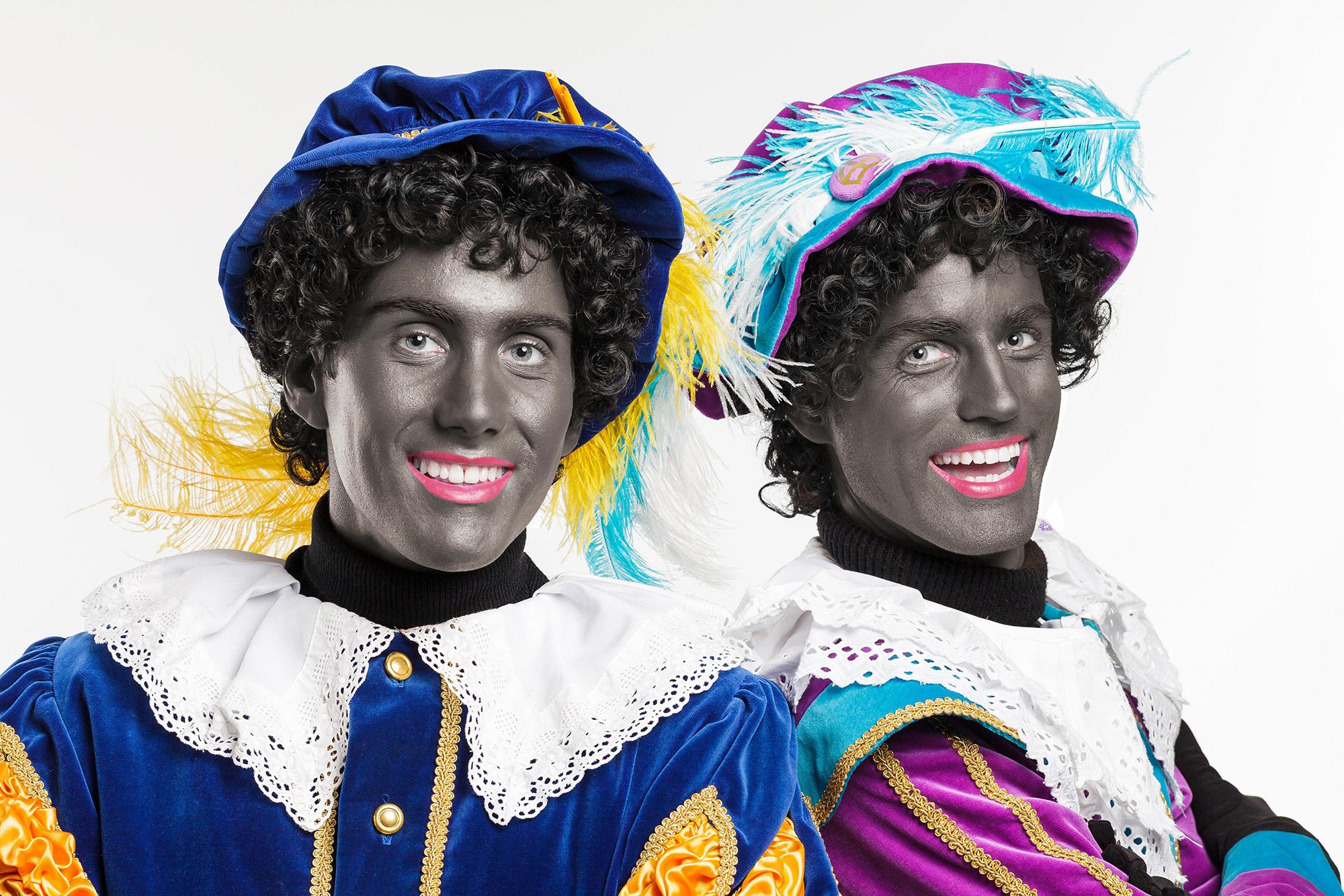
Those committed to being white and ruled by men have lost their collective way. Having once fantasized they possessed America or Europe or Israel solely for self-purpose, their distinctions notwithstanding, they now fear they don’t. Trump and Le Pen and Farage, Wilders, Baudet, Mussolini, Meuthen and Weidel, and Netanyahu—the list stretches on—are the expression of this fear of loss. The result is an unleashing of a collective mania of unhinged self-assertion, the trading of at least self-control for domineering dismissal and violent violation. Trumpomania as a placeholder name for the general condition has released the drive to purge those seen as non-belonging, as the not-being of this “species,” as the resolution to the woes they take to represent. The fantasy is nothing short of self-deluded destruction parading as the nightmare of the purge. In the name of making America or Britain great or other polities self-protected, they diminish all dramatically. Seeking self-preservation they are destroying the aspiration to livable futures together among and between the heterogeneous, the multi-species, for the sake of a nostalgia for a fantasized lost past.
By contrast, living creatively together in the messy and mixed up worlds we collectively and interactively inhabit, anthropocenically, takes work. https://www.youtube.com/watch?time_continue=2&v=162VzSzzoPs This is the labor of creating together, of using wisely and caringly the available resources from the things of the world we inhabit to the enabling labor of our co-habitants, of being disposed to others respectfully, sensitively, as dignified beings. It is this calling to creative, interactive, collaborative efforts to make our complicated, mixed and mixed-up worlds together across boundaries and walls and borders that is our imperative today.
